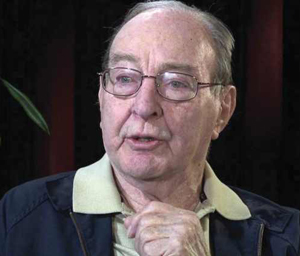The moonwalker lives in a pale-blue house at the end of a long driveway. Its defining feature is a steeply pitched entryway roof that points unambiguously to the heavens.
I ask several employees at the CVS a couple of blocks from the house if they know Edgar Mitchell. Not a blink of recognition, except for a 20-something girl in the pharmacy department. “Oh, sure — I think that’s a dress shop up the way,” she says.
Imagine that. Edgar Mitchell — the sixth human to walk on the surface of the moon, once widely feted by grateful heads of state for his historic achievement — is now a nearly anonymous 84-year-old with three dogs, a Toyota SUV, and a part-time assistant. He lives on five unmanicured acres in a South Florida suburb.
For the most part, he seems OK with being an ordinary old Earthling, his spaceman days long past. Test pilots tend to be both fatalistic and realistic in that way. As we sit across from each other in his living room, he sums up his extraordinary NASA career in three words: “I was competent.” A moment later, speaking of his Apollo 14 moon lander named Antares, he adds, “I had a good machine.”
Mitchell’s moment in the moonlight, if you will, occurred 44 years ago. He and fellow astronaut Alan Shepard landed in the Fra Mauro region, where they spent 33 hours conducting scientific experiments (and clowning around a bit on camera). Mitchell still holds the record for the longest walk on the moon. He doesn’t boast about it, but he’s hung a document that certifies the trek.
It is in the modern-day DNA of America to manufacture heroes, to nourish them and genuflect before them. That was somewhat less true on the afternoon of January 31, 1971, when Mitchell, strapped into a cramped command module atop 960,000 gallons of rocket fuel, blasted off before a worldwide TV audience. Our cultural perspective has since shifted. Today, we call first responders our national heroes; LeBron James is a hero to millions of kids; hell, even the Congressional Sergeant at Arms may be a heroic figure to ambitious, first-year security officers everywhere. But their enduring light will be but a flicker compared to Ed Mitchell’s death-defying achievement. Mitchell is one of only eight living men in the entire arc of human civilization to have visited our satellite moon — the moon! His feat is literally otherworldly.

And yet the brain-bending truth is that these days Mitchell is just another suspenders-wearing retiree who has gently touched down in the Florida sunshine. He meditates every morning, sometimes listens to honky-tonk music, plays sudoku “with pleasure,” and, he insists, seldom contemplates the moon.
Visitors, such as me, will sometimes get a tour of what he calls “the museum” — that is, the entirety of his home — which is bursting with astronaut memorabilia. So, while Mitchell insists he never stares at the moon, he doesn’t need to. It stares back at him from every inch of his pad. The most remarkable artifact of all is nearly lost among the clutter of his office: the actual control stick from the Antares lander, wires sprouting from its bottom.
When Mitchell left NASA in 1972, he was awarded a standard pension. Hardly enough money to live on. It’s not widely known, but astronauts receive no special compensation for their risk-taking. Demeaning though it was, Mitchell briefly accepted a job at the National Enquirer, which required chiefly that he introduce its owner to a succession of psychics, whom he knew because of his interest in parapsychology. It was a mistake, he admits. “But I had to make a living.” Again, imagine that.
In the years since, Mitchell has consulted on several documentaries and Hollywood films (Apollo 13, for example, which in real life he helped rescue from disaster). On others’ recommendations, he watched bits of the hit 2013 movie Gravity. “Not impressed,” he says to me, twice.
It pleases him that nowadays he is known for something other than bounding along on moon dust. He is among the high priests of quantum physics and is the founder of the Institute of Noetic Sciences, which explores the nature of consciousness. If you’re willing to pay, he’ll join you in a Skype conversation on these topics. “I’m a cosmologist, looking for the answers to the deep questions about our planet,” he says. “Returning from the moon, seeing the heavens from that perspective, I had a sense of wonder and joy and beauty.”
The moonwalker down the road, who neither seeks nor receives much hero worship, is concerned about the future of our planet. “We are consuming at an alarming rate,” Edgar Mitchell tells me. “We won’t endure another hundred years,” And so? “We have to get some of our people to go elsewhere. Mars.”
—
Edgar Mitchell passed away at age 85 on February 4, 2016, one day before the 45th anniversary of his moon landing.
Become a Saturday Evening Post member and enjoy unlimited access. Subscribe now




Comments
All stories about early NASA are great. Thank You